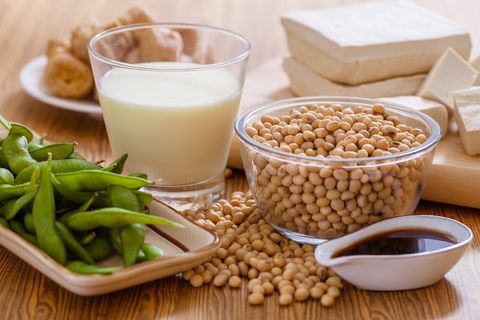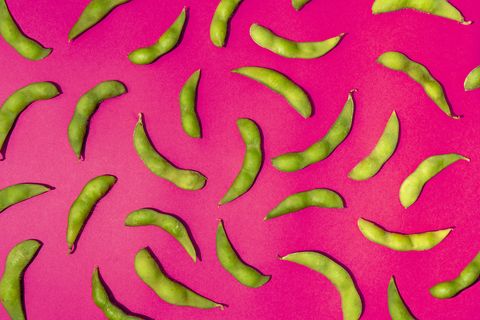With more Americans exploring a plant-based diet to improve their overall health and the health of the planet, soy-based foods such as tofu, edamame, soy milk, miso and meat substitutes like tempeh are becoming more popular and no longer relegated to health-food stores. Few products are as nutritionally beneficial as unprocessed forms of soy when you are following a plant-forward diet. It is a complete source of protein and contains all nine essential amino acids, which your body cannot produce and must get from food. For vegans, vegetarians and those who just are veg-curious, unprocessed soy is a protein-packed way to replace meat and dairy. That said, there is a lot of conflicting info out there that may make you question just how good soy actually is for you.
Let’s sit back with a nice glass of soy milk and a slice of tofu-based peanut butter pie and discuss.
How nutritious is soy?
For the most part, you can dig into your stir-fried tofu and sip that soy latte without worry. “Soy is an excellent source of plant-based protein and fiber. It’s low in saturated fat and can provide a more economical way to eat a balanced diet,” says Amy Fischer, M.S., R.D.N., C.D.N, a registered dietitian at the Good Housekeeping Institute. “It’s a complete protein and is a rich source of B vitamins, fiber, potassium and magnesium, among others. It also contains isoflavones (plant estrogens), which recent research indicates, may reduce the risk of breast cancer in pre- and post-menopausal women, and it may improve bone health,” adds Fischer.
“Soybeans provide a slew of vitamins and minerals crucial for reducing the risk of chronic disease; and fiber that helps you fill up and feel satisfied,” adds Jaclyn London, MS, RD, CDN author of Dressing on the Side (and Other Diet Myths Debunked).
Nutritional breakdown for popular forms of soy:
- Tofu: A half-cup of raw, firm tofu has 94 calories, a little over 10g of protein, 5g of fat and 227 mg of calcium.
- Tempeh: A half-cup has about 110 calories, about 15 g protein and 9g of fat, depending on the brand.
- Soy milk: One cup has 110 calories, 8g of protein and hardly any fat (though many brands contain added sugar).
- Miso: A paste made from fermented soybeans, miso has (per tablespoon) about 33 calories, 2.2g of protein and just 1g of fat.
Of course, one thing to remember when you’re choosing which type of soy to try is that whole foods are always better. Many of the provocative articles about the “risks” of eating soy are based on eating products made from soy protein isolates (think supplements, protein bars and meat alternatives). “Soy protein isolate, where the protein has been isolated from the soybean, does not have the same benefits that unprocessed or whole soy does,” Fischer explains. “During processing, valuable vitamins and minerals get stripped away. In addition, chemicals from the refining process could potentially be introduced.”
Why is soy controversial?
Let’s take a trip back to the 1990s when soy foods first started really hitting it big. At the time, many experts believed that soy had the power to fight problems like obesity, heart disease and even cancer. After all, people in Asia eat a ton of soy, and studies showed that these populations had significantly lower rates of obesity, heart disease and breast cancer compared to people in the U.S. Clearly, soy was the miracle food, right?
Not necessarily. Those studies only looked at association, not causation. Just because people who consume a lot of soy also happen to be healthier than people who don’t eat soy doesn’t automatically mean that soy is the key to their superior state. Countless other factors — including genetics, lifestyle and the rest of their diet — also play a role.
When researchers began taking a closer look to find out what made soy so healthy, they ran into some surprises. Soy, it turned out, contains estrogen-like compounds called isoflavones. And some findings suggested that these compounds could promote the growth of some cancer cells, impair female fertility and mess with thyroid function. Some health experts also trash-talk soy because of its potential to be an endocrine disrupter — meaning it can mimic estrogen in the body, which may lead to a hormone overload. But it turns out, many of these studies were performed on animals that process soy differently than humans.
At the same time, other studies were still showing that soy consumption could cure high cholesterol and help women cope with the symptoms of menopause. Dawn Jackson Blatner, RDN, a Chicago-based dietitian, says that while whole soy contains natural plant estrogens, they are much weaker than actual human hormones, and shouldn’t cause you to worry.
There has also been concern that the isoflavones in soy can affect men’s hormonal levels, lowering testosterone and raising estrogen levels. But a recent review of 41 studies found no apparent effect of hormonal disturbance as a result of soy protein or isoflavone intake.
Healthy benefits and downsides of soy
It’s hard to be black and white about soy. As with all foods, experts still don’t know everything there is to know. Research in recent years suggests that moderate consumption of minimally processed soy foods (more on what those are later) not only isn’t bad for you, it probably has some benefits. Here’s what we can say about soy today:
May decrease your risk of certain cancers
How did soy even get linked to cancer risk in the first place? Soy contains phytoestrogens (which are essentially plant estrogens) and high levels of estrogen in general have been linked to breast cancer. That said, research shows that food sources of soy and the plant estrogens found in soy do not increase the risk of cancer, according to the American Cancer Society. In fact, an analysis of more than 30 studies showed that soy intake reduced the risk of breast cancer for both pre- and post-menopausal women in Asian countries, where people tend to start eating soy from a very young age.
Eating soy could help protect against other types of cancer, too. Findings show that soy consumption may slightly lower the risk for gastrointestinal cancers and have a protective effect in prostate cancer survivors. Eating a high-fiber diet is also tied to lower colon cancer rates, and soy foods like edamame and tempeh both have plenty of roughage.
May improve fertility and hot flashes
Soy appears to be beneficial for fertility, as long as you don’t eat too much. Women undergoing in vitro fertilization who have environmental exposure to BPA are more likely to get pregnant if they also ate soy. That’s likely because soy’s isoflavones help neutralize the BPA’s endocrine-disrupting effects, researchers say.
Just don’t go overboard. Consuming over 100mg of soy isoflavones (the equivalent of 6 ounces of uncooked tempeh or 16 cups of soy milk) daily was linked to reduced ovarian function, according to the Journal of Nutrition review. On the other hand, moderate soy consumption didn’t pose a problem.
As for soy solving those annoying and disruptive hot flashes that accompany menopause? It might help, but not for everyone. Among women whose bodies produce the soy metabolite equol, those who ate the most soy experienced significantly fewer hot flashes and night sweats compared to those who ate the least, found one Menopause study. Between 20% and 50% of North American and European women produce equol. Some research centers can test for it in a urine sample, but there’s an easier option: Try adding soy to your diet for four to six weeks and see what happens. If it helps, you produce equol. If it doesn’t, you probably don’t, the study authors say.
May protect your heart
Early research suggested that soy could help lower levels of bad cholesterol, although more recent findings have shown that might not be the case. In 2008, the American Heart Association said that there was not enough evidence to say for sure that soy lowered the risk of heart disease. However, some interesting new research has suggested that fermented soy products such as natto may be protective against both cardiovascular disease and cancer. “I was recently introduced to natto, a staple in Japan that is lesser known stateside,” says Fischer. “It’s a delicious form of fermented soybeans that is often served with rice and enjoyed for breakfast.”
One of the healthiest aspects of eating soy comes via what it replaces on your plate: Swapping out animal-based foods for plant-based foods like soy lowers saturated fat intake and ups fiber intake, both of which help your heart. In other words, skipping that steak and cooking tofu or tempeh instead is a heart-smart move.
May affect your thyroid
Soy foods don’t affect thyroid function in people with healthy thyroids, found a Loma Linda University review of 14 studies. But, if you have an underactive thyroid you might want to watch how much soy you eat. Soy foods have been shown to interfere with the body’s absorption of thyroid medication — but only if you overdo it, suggests a 2016 Nutrients review. The evidence is still far from conclusive, but experts still advise waiting at least four hours after consuming soy to take your thyroid medicine.
The best (and worst) types of soy to eat
All of soy’s potential benefits come with an important caveat: To reap them, you need to pick minimally processed forms of soy — think tempeh, tofu, miso and edamame.
These foods serve up soy’s entire nutritional package without added sugar, unhealthy fats, sodium or preservatives that you usually find in highly processed foods. Fischer recommends using tempeh or tofu to replace the meat in tacos or chili and to keep a bag of frozen edamame around to snack on when you crave a crunchy bite.
Processed forms of soy such as meat alternatives, soy bars, soy yogurts or protein powders usually only contain soy protein isolates, rather than nutrition from the whole soybean. “Just as other processed foods are lower in nutrient density, removing the protein from the other enzymes and bacteria needed for digestion affects the nutritional quality,” says Taz Bhatia, MD, integrative health expert and author of What Doctors Eat.
As for how often you should eat soy? As with all foods, moderation is the way to go. Generally, three to five servings of minimally processed soy foods per week are perfectly fine, Bhatia says. If you are unsure or you have an underlying health condition (like hypothyroidism), bring it up with your doctor the next time you discuss your diet. If you want to mix it up with other plant-based proteins, consider incorporating more legumes, such as lentils and chickpeas into your diet, as well as hemp seeds and quinoa, Fischer suggests.
The bottom line
Add it all up, and you can see how this little green bean became a source of mass dietary confusion. Yes, soy should be in your diet, but like so many other foods, over-processing can be cause for concern. The current evidence suggests, in the case of soy, that the health benefits of eating unprocessed forms of soy in moderation outweigh the risks.
Marygrace Taylor is a health and wellness writer for Prevention, Parade, Women’s Health, Redbook, and others. She’s also the co-author of Prevention’s Eat Clean, Stay Lean: The Diet and Prevention’s Mediterranean Kitchen. Visit her at marygracetaylor.com.
This content is imported from OpenWeb. You may be able to find the same content in another format, or you may be able to find more information, at their web site.


